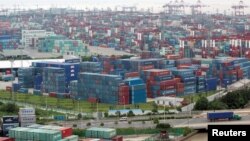A new set of tit-for-tat tariffs imposed by the United States and China on each other's goods took effect Thursday.
The U.S. announced earlier this month that it would impose 25 percent tariffs on $16 billion worth of Chinese goods, on top of the 25-percent tariffs it imposed on $34 billion worth of Chinese products in early July. Beijing has followed suit in each case with an identical percentage of tariffs in retaliation.
China's commerce ministry issued a statement Thursday criticizing the U.S. tariffs as a violation of World Trade Organization rules, and says it will file a legal challenge under the WTO's dispute resolution mechanism.
The new round of tariffs took effect the day after delegations from both nations met in Washington for first of two days of talks aimed at resolving the dispute, the first such formal discussions since June.
U.S. President Donald Trump told Reuters in an interview this week he does not expect much progress from the discussions.
When asked about the issue at Wednesday's news briefing by VOA, White House Press Secretary Sarah Huckabee Sanders said, "As you said, these conversations are continuing. I don't have any announcements on them. They're ongoing. Certainly, what we'd like to see is better trade deals for the United States. he president wants to see free, fair, and more reciprocal trade between other countries, particularly with China, and we're going to continue in those conversations."
The Trump administration is demanding that Beijing change its practice of heavily subsidizing its technology sector and open its markets to more U.S. goods.
The U.S. Trade Representative's office on Monday began six days of public hearings on the president's plans to impose tariffs on a wider array of Chinese imports, affecting an additional $200 billion worth of Chinese goods.
Economists warn that the trade war between the world's biggest economies would reduce global economic growth by around 0.5 percent through 2020.









